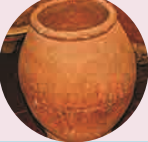Vedic Culture in North India and Megalithic Culture in South India Notes 6th Social Science
Vedic Culture in North India and Megalithic Culture in South India Notes 6th Social Science
6th Social Science Lesson 9 Notes in English
9. Vedic Culture in North India and Megalithic Culture in South India
1. When was Vedic Age Started?
The first phase of urbanisation in India came to an end with the decline of Indus Civilisation. A new era, called Vedic Age began with the arrival of Aryans.
2. What is Vedic Age?
Vedic Age – It is a period in the History of India between 1500 BC (BCE) – 600 BC (BCE). It gets its name from four ‘Vedas’.
3. Who were Aryans?
- The Aryans were Indo–Aryan language speaking, semi nomadic pastoralists.
- They came from Central Asia in several waves of migration through Khyber Pass of Hindu Kush Mountains.
4. What was the Main occupation of Aryans?
Though cattle rearing was their main occupation, they also practised slash and burn agriculture.
5. Slash and burn agriculture – It is a farming method that involves clearing the land by cutting and burning all the trees and plants on it. Cultivation is done there for a short time and then abandoned. People then move to a new piece of land for cultivation.
6th Social Book Back Questions
6. Show the extent of Vedic culture in India:
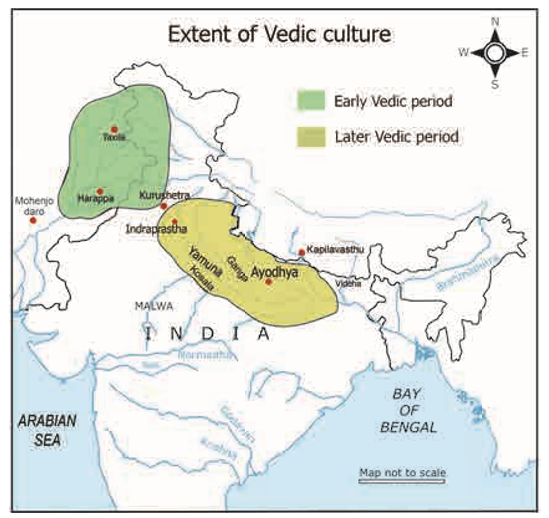
7. Mention the time, Spread and Source of Vedic Age:
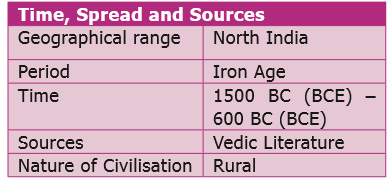
8. What were the Home of Aryans?
Aryans of the Rig Vedic Period were seminomadic. They were basically pastoral people with cattle as their main source of wealth.
9. What is called Sapta Sindhu?
In the Rig Vedic times, the Aryan homeland was the Punjab, which was at that time called Sapta Sindhu, the land of seven rivers.
10. Various Actions of Aryans:
- Around 1000 BC (BCE), Aryans in India moved eastward and settled in Indo-Gangetic Plain.
- Use of iron axes and ploughs became widespread.
11. Mention the Four Vedas:
- Rig
- Yajur
- Sama
- Atharva
12. What is Shrutis?
- The Shrutis comprise the four Vedas, the Brahmanas, the Aranyakas and the Upanishads. They are considered sacred, eternal, and an unquestionable truth.
- ‘Shruti’ means listening (or unwritten) ones that were transmitted orally through generations.
13. What is Smritis?
- A body of texts containing teachings on religion such as Ithihasas, Puranas, Tantras and Agamas. Smritis are not eternal. They are constantly revised.
- ‘Smriti’ means definite and written literature.
14. Mention the Vedic Texts:
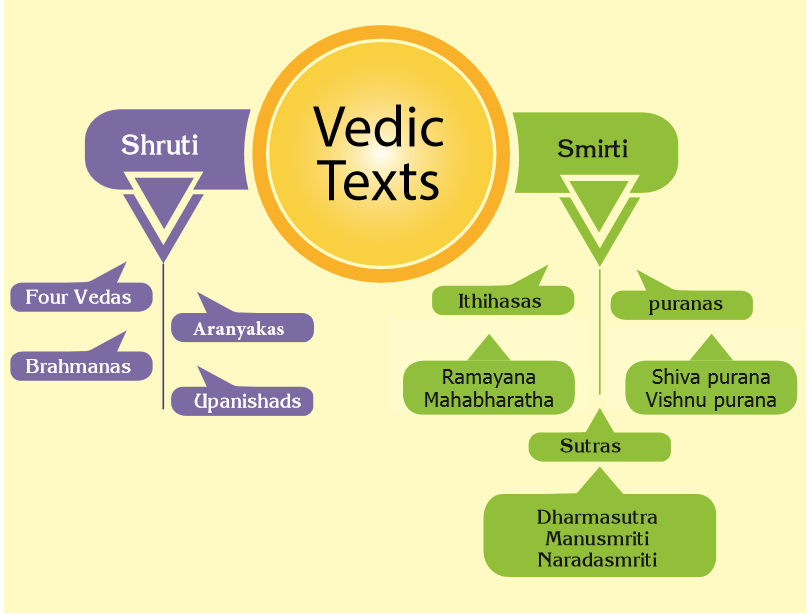
15. Show the Classification of Vedic Age:
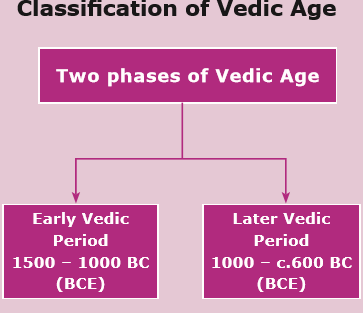
16. National Motto “Satyameva Jayate” “(Truth alone triumphs)” is taken from Mundaka Upanishad.
17. Various places which has Archaeological Evidence of Vedic Age:
Material remains such as iron implements and pottery from the archaeological sites in Punjab, Uttar Pradesh and Rajasthan along the Indus and the Ganges.
18. Bali – a tax consisting of 1/6 of the agricultural produce or cattle for a person.
19. What was the unit of Polity in Vedic Age?
The Rig Vedic polity was kinship – based. Kula (clan) was the basic unit of the polity. It was under a head called Kulapati.
20. Who was Gramani?
Several families joined together to form a Grama (village). Grama was headed by Gramani.
21. Who was the guardian of People?
A group of villages was called Vis (clan) and was headed by Vishayapati. Rajan was the head of the Jana (tribe) and he was addressed as Janasyagopa (guardian of the people).
22. What were the Tribal peoples called?
There were several tribal kingdoms (Rashtras) during Rig Vedic period (Bharatas, Matsyas, Puras).
23. What were the responsibility of Rajan?
The main responsibility of the Rajan was to protect his tribe. His powers were limited by tribal assemblies namely Vidhata, Sabha, Samiti and Gana. Of these Vidhata, (the tribal assembly) was the oldest.
24. Whom replaced the territorial kingdom?
When the Aryans moved east ward- into Ganges-Yamuna-Doab regions, the early settlements were replaced by territorial kingdoms.
25. Why did the king perform rituals?
In the monarchical form of government, the power of the king increased and he performed various rituals and sacrifices to make his position strong.
26. What were the kingdom of Vedic Age?
The Kuru and Panchala kingdoms flourished and large cities like Ayodhya, Indraprastha and Mathura also emerged during this period
27. What are Dasyus and Dasas?
The Vedic family was patriarchal. The fair complexioned Aryans distinguished themselves from dark complexioned non-Aryans whom they called Dasyus and Dasas.
28. What were the three divisions of Early Vedic Society?
Within the early Vedic Society there were three divisions (Treyi) ; the general public were called Vis, the warrior class was called Kshatriyas and the Priestly class was named Brahmanas.
29. What are Varna System?
At a later stage, when the Aryans had to accommodate non-Aryan skilled workers in their social arrangement, a rigid four-fold Varna system was developed, i.e., the priestly Brahmanas, the warrior Kshatriyas, the land owning Vysyas and the skilled workers sudras. Thus a graded social order emerged.
30. Sabha – a council of elders.
31. Samiti – assembly of people.
32. Role of Women in Early Vedic:
- In Rig Vedic society, women relatively enjoyed some freedom.
- The wife was respected as the mistress of the household.
- She could perform rituals along with her husband in their house.
- Child marriage and sati were unknown.
- There was no bar on the remarriage of widows.
33. Does the early vedic women has property Rights?
The women were denied right to inherit property from their parents. They played no role in public affairs.
34. Role of Women in Later Vedic:
- In the later Vedic period the role of women in society, as well as their status, even within the family, declined.
- Women could no longer perform rituals in the family.
- The rules of marriage became much more complex and rigid.
- Polygamy became common.
- Widow remarriage was not encouraged.
- Education was denied to women.
- Intercaste marriages were spurned.
35. What were the occupation of Vedic period?
Economy in the Vedic period was sustained by a combination of pastoralism and agriculture. Though occupation of Rig Vedic Aryans was cattle rearing, there were carpenters, chariot makers, potters, smiths, weavers, and leather workers.
36. Main invention of this period:
Ochre Coloured Pottery (OCP) was attributed to this period.
37. What were the animals domesticated by them?
Horses, cows, goats, sheep, oxen and dogs were domesticated.
38. What was their staple crop?
The staple crop was yava (barley). There is no mention of wheat or cotton in the Rig-Veda, though both were cultivated by the Indus people. Two crops a year were raised.
39. What were the animals domesticated in later vedic?
In the later Vedic period the Aryans tamed elephants, apart from cow, goat, sheep and horse.
40. What were the various occupation of Later vedic?
In addition to craftsmen of early Vedic period there were also jewellers, dyers and smelters. Pottery of this period was Painted Grey Ware Culture. Use of iron plough and axe helped to put more areas of land under cultivation.
41. What were the crops of later vedic?
Crops of wheat, rice and barley were cultivated. With the growth of agriculture, the idea of private possession of land came into existence.
42. What were the coins used by them?
They used Nishka, Satmana (gold coins) and Krishnala (silver coins) for business transactions.
43. Metals Known to Rig Vedic People
- Gold (Hiranya)
- Iron (Shyama)
- Copper/ Bronze (Ayas)
44. More on Rig Vedic People:
Aryans worshipped mostly the earthly and celestial gods like Prithvi (Earth), Agni (fire), Vayu (wind), Varuna (rain), Indra (Thunder). There were also lesser female deities like Aditi (goddess of eternity) and Usha (appearance of dawn).
45. Whose welfare does rig vedic people pray?
People prayed for the welfare of Praja (children) Pasu (cattle) and Dhana (wealth). Cow was considered a sacred animal.
46. Whorship pattern of Rig Vedic:
There were no temples. Idol worship had not yet come into existence. Lateron priesthood became a profession and a hereditary one. New gods were perhaps adopted from non-Aryans.
47. Various Gods of Rig vedic Society:
Indra and Agni lost their importance. Prajapathi (the creator) Vishnu (the protector) and Rudra (the destroyer) became prominent. Sacrifices and rituals became more elaborate.
48. What is gurukula system?
The gurukula system is an ancient learning method.
49. What does the word Gurukula mean?
The word Gurukula is a combination of the Sanskrit Word Guru (teacher or master) and Kula (family or home).
50. What were taught in Gurukulam?
The subjects of the study included the four Vedas, Ithihasas, Puranas, grammar, logic, ethics, astrology, maths and military science. The students were also trained to lead a disciplined life.
51. What were the four stages of Life?
- Brahmacharya (Student Life)
- Grihastha (Married Life)
- Vanaprastha (Going to the forest to meditate)
- Sanyasa (Leading a life of an ascetic so as to attain Swarga)
52. Periplus mentions the steel imported to Rome from Peninsular India was subjected to duty in the port of Alexandria.
53. What is Menhir?
Menhir–In Breton Language ‘Men’ means “stone” and ‘hir’, “long.” They are monolithic pillars planted vertically into the ground in memory of the dead.
54. Mention the places were Menhir found?
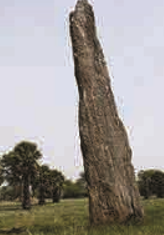
- Menhir at Singaripalayam in Tirupur District and at Vembur in Theni District points to the existence of an ancient settlement along the banks of River Uppar.
- Menhirs are found at Narasingampatti, Madurai district, Kumarikalpalayam and Kodumanal in Erode district.
55. What is Hero Stone?
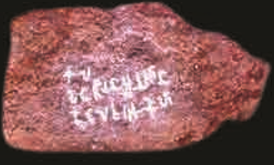
A Hero Stone is a memorial stone raised in remembrance of the honourable death of a hero in a battle or those who lost their lives while defending their village from animals or enemies.
56. Mention the Places where Hero stones are found?
Hero stones are found at Maanur village near Palani, Dindigul district, Vellalankottai, Tuticorin district, and Pulimankombai, Dindigul district.
57. Megalithic Monuments in Tamil Nadu
- The people who lived during the last stages of the New Stone Age began to follow the Megalithic system of burial.
- According to this system, the dead body was placed in a big pot along with burial goods.
- The Megalithic monuments bear witness to a highly advanced state of civilisation with the knowledge of iron and community living.
58. What are Dolmens?
Dolmens are Megalithic tombs made of two or more upright stones with a single stone lying across the burial site.
59. Mention the Places where Dolmens found?
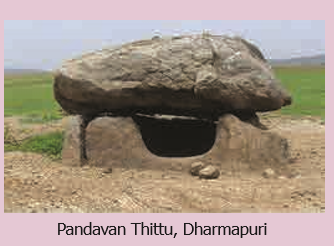
Megalithic Dolmens have been found in Veeraraghavapuram village, Kanchipuram district, Kummalamaruthupatti, Dindigul district, and in Narasingampatti, Madurai district.
60. What were the Exacavation at Kodumanal?
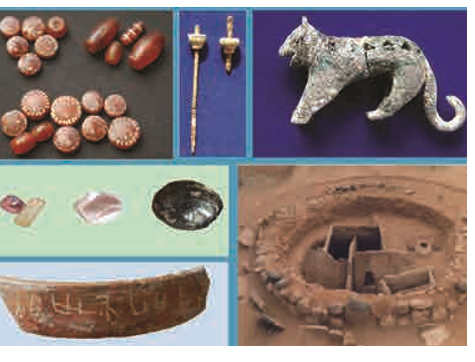
- Kodumanal – Erode District It is identified with the Kodumanam of Pathitrupathu.
- More than 300 pottery inscriptions in Tamil – Brahmi have been discovered there.
- Archaeologists have also discovered spindles, whorls (used for making thread from cotton) and pieces of cloth, along with tools, weapons, ornaments, beads, particularly carnelian. A Menhir found at burial site is assigned to the Megalithic period.
61. Paiyampalli – Vellore District Archaeological Finds
- Iron artefacts, along with Megalithic Black and Red Ware Pottery have been found.
- Evidence for iron smelting has come to light at Paiyampalli.
- The date of this culture, based on radio carbon dating, is 1000 BC (BCE).
62. Porunthal – Dindigul District Finds – Grave goods, glass beads (in red, white, yellow, blue and green), iron swords, pottery with Tamil Brahmi scripts, pots filled with rice, semi-precious metals such as quartz, carnelian, bangles made of glass and shell.
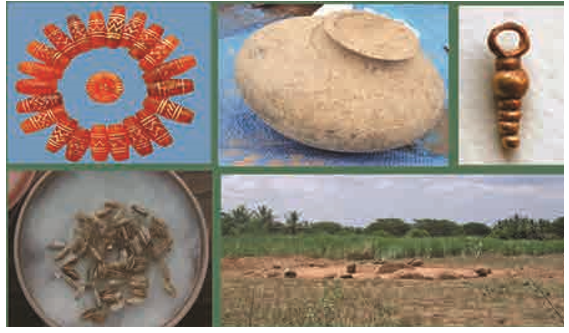
63. Which proves that rice was staple food?
The discovery of iron sickle, pike, and tip of ploughs provide evidences that they had the practice of rice cultivation in Tamil Nadu. A pot of rice from Porunthal site proves that rice was people’s staple food.
64. Keezhadi – Sivagangai District
The Archaeological Survey of India (ASI) excavated an ancient town dating to Sangam Age in Keezhadi village at Tirupathur taluk. Excavations have produced evidence for brick buildings, and well laid – out drainage system.
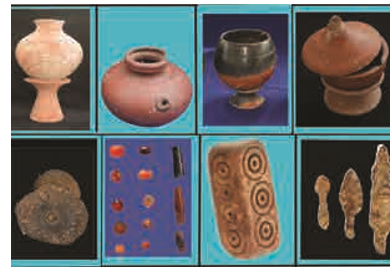
65. Various findings at Keezhadi:
Tamil – Brahmi inscription on pottery, beads of glass, carnelian and quartz, pearl, gold ornaments and iron objects, shell bangles, ivory dice have been unearthed.
66. Sample Evidence at Keezhadi:
In 2017, ASI sent two samples of these for Radio carbon dating to Beta Analytic, Florida, USA. They dated samples as 200 BC (BCE). The Roman artefacts found at the site add to the evidence of ancient Indo -Roman trade relations.
67. What is Chalcolithic period?
The early Vedic culture in northern India coincided with Chalcolithic cultures that prevailed in other parts of the sub-continent. Since, people used copper (chalco) and stone (lithic), it was called Chalcolithic period. The later Vedic culture in north India and the Iron Age in south India belong to the same period.
68. Megalithic Period:
Towards the end of Iron Age, people stepped into what is known as Megalithic Culture (600 BC (BCE) and AD (CE) 100). Megalithic Period in ancient Tamilakam synchronised with the pre Sangam period. The Black and Red Ware Pottery became the characteristic of the Megalithic period.
69. Define the term Megalithic:
The term ‘Megalith’ is derived from Greek. ‘Megas’, means great and ‘lithos’ means stone. Using big stone slabs built upon the places of burial is known as Megalith.
70. Adichanallur – Thoothukudi District :
Among the artefacts unearthed were Urns, pottery of various kinds (Red Ware, Black Ware), iron implements, daggers, swords, spears and arrows, some stone beads and a few gold ornaments.
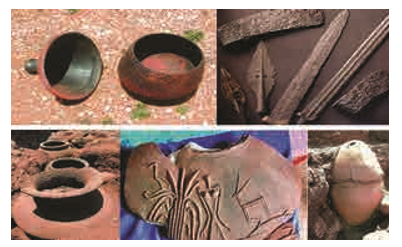
71. Various objects from Adichanallur:
Bronze objects representing domestic animals and wild animals like tiger, antelope and elephant have been unearthed.The people were skilful in making pottery and in working stone and wood.
72. Urns – large pottery jars were used for burying the dead.
